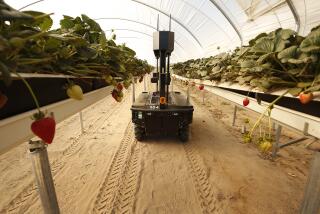Home (and college) on the range
- Share via
kingsville, texas -- From a laptop computer in a university classroom beams a long list of letters and numbers -- an equation, Les Nunn tells his colleagues in cowboy hats, for getting the most beef out of your pastures’ grass.
It’s noon Friday at Texas A&M; University-Kingsville’s nascent Institute for Ranch Management, time for brown-bag lunches and “bullosophy.” Nunn’s PowerPoint presentation, “Searching for the Economic Optimum Stocking Ratio,” follows another student’s profit-loss analysis of a government incentive program for land conservation and another’s stab at formulas for sharing land between hunting lessees and livestock.
University officials tout the institute as the world’s first master’s degree program in ranch management, the equivalent of a Harvard Business School for those who would take a “systems” approach to the Wild West. In addition to graduate-level business courses, students are schooled in range land specialties, including animal nutrition and wildlife management.
It’s an exclusive club, coming with the promise of a job after graduation. The first graduating class had two students; the current class has four, with seven students enrolled in the program this year. Twenty students applied for a slot.
The program signals a new era for the occupation. In the past, those aspiring to careers in ranch management might have pursued degrees in animal science or agriculture and rounded out their resumes with on-the-job training. Today’s ranchers also need business and wildlife management skills.
“You can’t just be an animal nutritionist and horse person and manage a ranch anymore,” said Barry Dunn, a former South Dakota rancher with a doctorate who heads the program.
“The market for most of ranching’s history has been a commodities market,” he said. “But now the markets are moving into specialized [fields] -- whether it’s hunting or specialized beef production, like Nolan Ryan beef. All of that just adds more and more sophistication.”
The King Ranch, which endowed the institute and allows students to do fieldwork on its grounds, epitomizes the kind of modern ranch the school wants its students to be able to manage.
At 825,000 acres, it is the largest ranch in the United States -- so vast that it appears as a dark spot from space, so unspoiled that it has more species of birds than Florida’s Everglades. It includes a small school district for its employees’ children. It originated several cattle strains and is considered the birthplace of American ranching.
But these days, raising cattle is only a small part of the ranch’s operations, which include oil and gas leases, ecotourism, hunting tours, a publishing company and a retail arm. The ranch also farms cotton and citrus. Its corporate headquarters is in Houston, 200 miles away.
David Delaney, vice president and general manager of ranching operations, said he spends at least 60% of his time in front of a computer, managing all the operations with charts and spreadsheets. Much of the other time he’s out hobnobbing, “being the face of the King Ranch.” Yet he still knows each of the ranch’s 160 pastures, and a stop with students to view grazing heifers turns into an impromptu lecture on the merits of various feed grass.
“I would have gone to this program if it had been available at the time,” said Delaney, who grew up in Virginia and initially wanted to be a veterinarian. “But there was no such thing.”
Students already have helped the ranch by using computer modeling to show which deer to develop to attract hunters, determining how many heifers to expose to each bull to maximize breeding, and developing an electronic identification system for animals in advance of the federal National Cattle Identification System, which is due to start tracking diseases in 2009.
The institute opened with two students in 2004, who graduated in 2006.
Dunn said the institute planned to limit each class to four students, who enroll as fellows and receive free tuition, university health benefits and a modest living stipend for the two-year program. Summers are spent doing internships at ranches across the country.
Class size is kept small to ensure that the institute remains elite and is able to place its graduates in jobs, Dunn said.
Though students will be equipped to manage mega-ranches such as the King Ranch, Dunn said they would also have the blend of skills needed to run federal parks or wildlife refuges.
Current students range in age from 29 to 43 and come from Texas, Oregon, South Dakota, Florida, Arizona, Nevada and New Mexico.
All said they embraced the business training and were able to rope in the math and complex theories with relative ease.
“Honestly, from the first day I met with the landowners, I felt like I was lacking in business skills,” said David Rios, who has a degree in wildlife management and had worked as a hunting lease manager at a ranch near his hometown of McAllen, Texas.
Delane Atcitty, who comes from a Navajo reservation in Tuba City, Ariz., said he hoped to work in the field awhile before bringing his new knowledge back to the reservation, which has plenty of horses and cattle but little tourism or other pursuits.
Doug Wilmeth, from New Mexico, said he had worked in various segments of the industry, including calving and packing, and wanted “to be able to tie it all together.”
Dunn said graduates could expect to be recruited for $50,000 to $75,000 to start, with salaries going up over time.
Ranch families may have gotten so big and spread out over the generations that the best way to handle management is to outsource it.
“The land that ranchers manage is really precious to all of us,” Dunn said. “We produce food for all of us and we produce recreation. Ranchers really have a unique role in society, and this little institute is trying to ratchet that up.”
More to Read
Inside the business of entertainment
The Wide Shot brings you news, analysis and insights on everything from streaming wars to production — and what it all means for the future.
You may occasionally receive promotional content from the Los Angeles Times.










